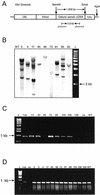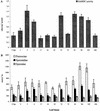Expression of a heterologous S-adenosylmethionine decarboxylase cDNA in plants demonstrates that changes in S-adenosyl-L-methionine decarboxylase activity determine levels of the higher polyamines spermidine and spermine
- PMID: 12177487
- PMCID: PMC166762
- DOI: 10.1104/pp.010966
Expression of a heterologous S-adenosylmethionine decarboxylase cDNA in plants demonstrates that changes in S-adenosyl-L-methionine decarboxylase activity determine levels of the higher polyamines spermidine and spermine
Abstract
We posed the question of whether steady-state levels of the higher polyamines spermidine and spermine in plants can be influenced by overexpression of a heterologous cDNA involved in the later steps of the pathway, in the absence of any further manipulation of the two synthases that are also involved in their biosynthesis. Transgenic rice (Oryza sativa) plants engineered with the heterologous Datura stramonium S-adenosylmethionine decarboxylase (samdc) cDNA exhibited accumulation of the transgene steady-state mRNA. Transgene expression did not affect expression of the orthologous samdc gene. Significant increases in SAMDC activity translated to a direct increase in the level of spermidine, but not spermine, in leaves. Seeds recovered from a number of plants exhibited significant increases in spermidine and spermine levels. We demonstrate that overexpression of the D. stramonium samdc cDNA in transgenic rice is sufficient for accumulation of spermidine in leaves and spermidine and spermine in seeds. These findings suggest that increases in enzyme activity in one of the two components of the later parts of the pathway leading to the higher polyamines is sufficient to alter their levels mostly in seeds and, to some extent, in vegetative tissue such as leaves. Implications of our results on the design of rational approaches for the modulation of the polyamine pathway in plants are discussed in the general framework of metabolic pathway engineering.
Figures





Similar articles
-
Expression of an antisense Datura stramonium S-adenosylmethionine decarboxylase cDNA in tobacco: changes in enzyme activity, putrescine-spermidine ratio, rhizogenic potential, and response to methyl jasmonate.J Plant Physiol. 2005 May;162(5):559-71. doi: 10.1016/j.jplph.2004.10.008. J Plant Physiol. 2005. PMID: 15940873
-
Spermine facilitates recovery from drought but does not confer drought tolerance in transgenic rice plants expressing Datura stramonium S-adenosylmethionine decarboxylase.Plant Mol Biol. 2009 Jun;70(3):253-64. doi: 10.1007/s11103-009-9470-5. Epub 2009 Feb 21. Plant Mol Biol. 2009. PMID: 19234674
-
Effects of spermidine synthase overexpression on polyamine biosynthetic pathway in tobacco plants.J Plant Physiol. 2004 Sep;161(9):989-1001. doi: 10.1016/j.jplph.2004.02.004. J Plant Physiol. 2004. PMID: 15499902
-
Polyamines.Annu Rev Biochem. 1984;53:749-90. doi: 10.1146/annurev.bi.53.070184.003533. Annu Rev Biochem. 1984. PMID: 6206782 Review. No abstract available.
-
[Polyamines in eukaryotes: intracellular and serum homeostatic mechanisms].Ann Biol Clin (Paris). 1979;37(6):317-25. Ann Biol Clin (Paris). 1979. PMID: 121211 Review. French. No abstract available.
Cited by
-
Modulation of the polyamine biosynthetic pathway in transgenic rice confers tolerance to drought stress.Proc Natl Acad Sci U S A. 2004 Jun 29;101(26):9909-14. doi: 10.1073/pnas.0306974101. Epub 2004 Jun 14. Proc Natl Acad Sci U S A. 2004. PMID: 15197268 Free PMC article.
-
Polyamines in the life of Arabidopsis: profiling the expression of S-adenosylmethionine decarboxylase (SAMDC) gene family during its life cycle.BMC Plant Biol. 2017 Dec 28;17(1):264. doi: 10.1186/s12870-017-1208-y. BMC Plant Biol. 2017. PMID: 29281982 Free PMC article.
-
Spermidine exodus and oxidation in the apoplast induced by abiotic stress is responsible for H2O2 signatures that direct tolerance responses in tobacco.Plant Cell. 2008 Jun;20(6):1708-24. doi: 10.1105/tpc.108.059733. Epub 2008 Jun 24. Plant Cell. 2008. PMID: 18577660 Free PMC article.
-
Molecular characterization of the Arginine decarboxylase gene family in rice.Transgenic Res. 2010 Oct;19(5):785-97. doi: 10.1007/s11248-009-9354-0. Epub 2010 Jan 16. Transgenic Res. 2010. PMID: 20082138
-
Reduction in the endogenous arginine decarboxylase transcript levels in rice leads to depletion of the putrescine and spermidine pools with no concomitant changes in the expression of downstream genes in the polyamine biosynthetic pathway.Planta. 2003 Nov;218(1):125-34. doi: 10.1007/s00425-003-1079-3. Epub 2003 Jul 24. Planta. 2003. PMID: 12898254
References
-
- Abeles FB. Ethylene in Plant Biology. New York: Academic Press; 1973.
-
- Bagni N. Polyamines in plant growth and development. In: Bachrach U, Heimer YM, editors. The Physiology of Polyamines. II. Boca Raton, FL: CRC Press; 1989. pp. 107–120.
-
- Bassie L, Noury M, Lepri O, Lahaye T, Christou P, Capell T. Promoter strength influences polyamine metabolism and morphogenic capacity in transgenic rice tissues expressing the oat arginine decarboxylase cDNA constitutively. Transgenic Res. 2000a;9:33–42. - PubMed
-
- Bassie L, Noury M, Wisniewski JP, Topsom L, Christou P, Capell T. Transgenic cell lines as a useful tool to study the biochemistry of down-regulation of an endogenous rice gene using a heterologous diamine oxidase cDNA. Plant Physiol Biochem. 2000b;38:729–737.
Publication types
MeSH terms
Substances
LinkOut - more resources
Full Text Sources
Other Literature Sources

